
HOS electronic logbook solutions for the US, Canada, the UK, and Australia
Driving long distances or for extended periods can be physically exhausting for commercial drivers. According to Road Safety Transport, fatigue is one of the big three killers on the road — hence driving time rules. Moreover, a person who has been awake for 17 hours has the same risk of getting into an accident as someone with a blood alcohol content of 0.05/100 mg, which is roughly equivalent to a couple of drinks. Both of these drivers are twice as likely to crash as someone with no blood alcohol content who is not tired. Drivers who have been awake for 24 hours are seven times more likely to be involved in an accident.

If drivers take regular breaks and their hours are monitored, they are much less likely to get tired and make a fatal mistake. Trucking businesses in various countries historically tracked work hours in paper log books, and some still do. However, compliance requirements have brought a need for software applications that, together with special hardware devices, can be used as part of hour logging systems. Similar requirements for trucking businesses have been introduced in the United States, Canada, the United Kingdom, and Australia.
In our article, we dive deep into the current requirements in each country and describe what kinds of apps might help trucking businesses comply with them. Let’s start by talking about US ELD requirements.
Electronic logging device (ELD) requirements in the US
In the US, more than 70 percent of the nation’s freight by weight is moved by trucks, and nearly six percent of all full-time jobs in the country are in the trucking industry. All of these fleet trucking companies, their staff, and their drivers need to make sure their operations are compliant with recent rules from the Federal Motor Carrier Safety Administration (FMCSA).
On December 18, 2017, a new electronic logging device (ELD) rule took effect in the US. All drivers and carriers who were found non-compliant with this rule were subject to penalties starting in 2018. To understand the full picture, we need to begin by explaining how this situation came about.
Which trucking businesses must comply with ELD rules?
According to the ELD Final Rule published by the Federal Motor Carrier Safety Administration, all trucking companies whose drivers had been recording their work hours using paper log books had to switch to ELD records. An ELD is a laptop, smartphone, or tablet with software that automatically records drivers’ hours of service. An ELD has to be synchronized with the commercial motor vehicle and should meet technical specifications described in the ELD rule.
Who is exempt from complying with the 2018 ELD rule?
- Drivers operating vehicles that were produced before 2000
- Drivers with commercial licences (CDL drivers) who operate within 100 air miles of their daily starting location
- Drivers (non-CDL) who operate within 150 air miles of their starting location
ELDs in 2021
In January 2021, FreightWaves published the results of a survey among users of the Road Hunter app — an application for truck drivers in the US and Canada. According to the survey, only a third of users are completely satisfied with their ELD provider. Thus, there is demand among potentially 70 percent of truck drivers for a new electronic logging device (ELD) provider.
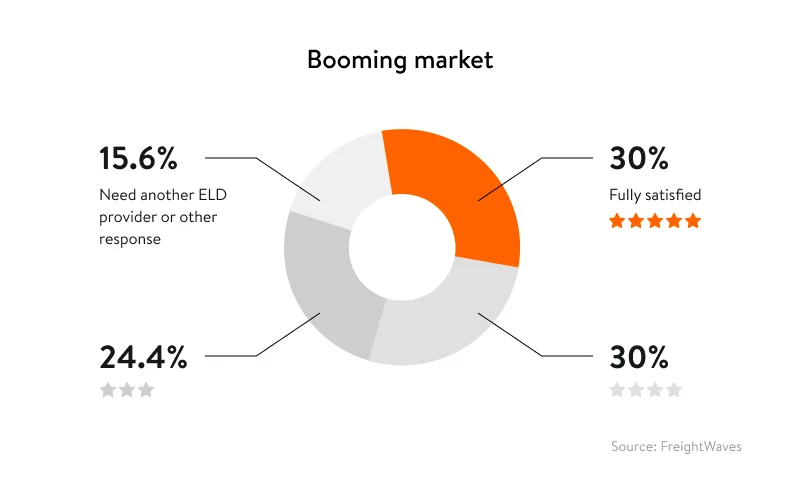
Although electronic logging devices (ELDs), sometimes referred to as Elogs, are positioned first as a fatigue management solution, it’s important to mention that ELogs have become the dominant source of data in transportation supply chain management.
Since industry-wide ELD adoption in the US in 2018, more and more ways have been devised to use electronic logging devices to your advantage, whether you’re a driver, a carrier, or a third-party logistics (3PL) provider.
If you’re integrating a new ELD solution or updating your existing solution, remember that combining ELD data with navigation data could open up additional insights. For example, it could result in helping drivers better utilize available driving hours and remain in compliance with hours-of-service (HOS) regulations.
Let’s look at the underlying technological requirements before you decide to update your trucker logbook app.
Electronic logbook app development: what to know about hardware and software to comply with requirements
Logbooks and HOS logging devices. A traditional paper logbook is a notebook with a time grid on every page dividing the 24-hour day into 15-minute segments.
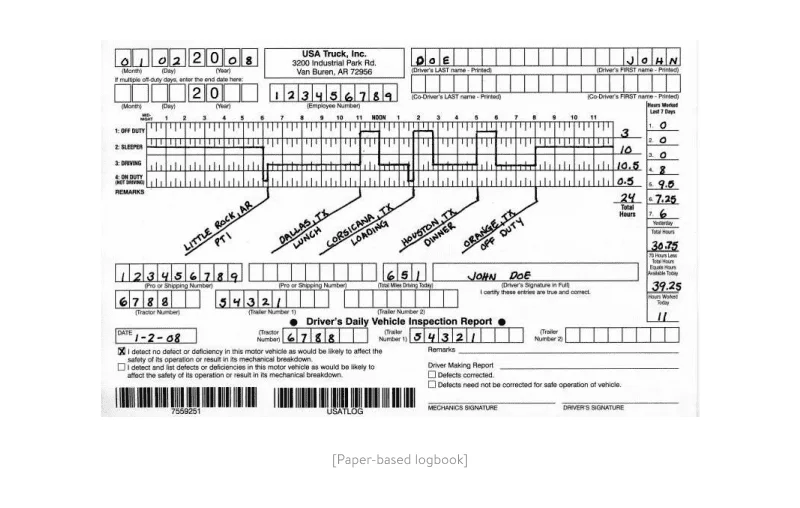
E-logging software allows drivers to generate a Record of Duty Status and submit the record with an electronic signature. This type of e-logging software doesn’t provide a connection to a truck’s engine, but rather relies on a driver’s manual input of HOS information.
Elogs, on the other hand, can record a driver’s compliance with HOS requirements more effectively than paper logbooks because they are linked to the vehicle’s hardware.
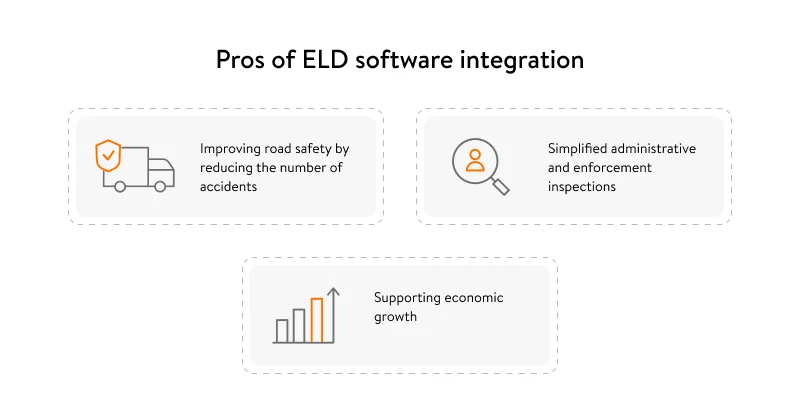
ELD devices also provide drivers and dispatchers with other benefits, reducing paperwork, helping drivers avoid financial penalties under the CSA program (Compliance, Safety, Accountability), and keeping dispatchers up to date on a driver’s status. Here is a list of types of Elog hardware devices that are currently available on the market:
- Automatic on-board recording devices (AOBRD) connect to the engine and record driver HOS information that can be shared with dispatchers. AOBRD devices can also produce a driver’s HOS chart upon demand.
- Fleet management systems provide a robust suite of applications, from GPS fleet tracking to messaging and fuel monitoring. Fleet management systems also include an AOBRD component.
- Electronic logging devices (ELDs) are the future for long-haul truck drivers. They synchronize with a truck’s engine to capture power status, motion status, miles driven, and engine hours. ELDs collect data including the date, time, location, engine hours, and vehicle miles as well as identification data on the driver, vehicle, and motor carrier.
An ELD must be able to either:
- Transmit data using wireless web services and email, or
- Transfer data locally using a thumb or flash drive (USB 2.0) and Bluetooth
Adopting new electronic logging technology may be costly for truck drivers, so the US Federal Motor Carrier Safety Administration allows for the use of smartphones and tablets running HOS solutions that meet the following ELD requirements:
- A hardwired connection to the truck’s engine, interfacing with the Engine Control Unit
- Resistance to tampering and support for data integrity check functions
- Vehicle location tracking and automated entry at each change of duty status
- A graph grid for presenting a driver’s daily status changes either on a display unit or on a printout
- A driver should be allowed to log in and select an “on-duty,” “off-duty,” or “on-duty not driving” status (the “driving” status must automatically be activated by vehicle movement).
- HOS data should be standardized for transmission to law enforcement officers on a real-time basis using wireless connections such as Bluetooth.
Now let’s discuss how you can build an electronic logbook app for truckers in more detail.
ELD app development
According to the FMCSA ELD rules, an HOS electronic logbook solution for smartphones or tablets consists of three parts:
- A mobile app for drivers
- A mobile app for dispatchers
- A hardware device that connects to the truck’s engine
Read also: Writing a Request for Proposal to Your Potential Software Partner
How does an ELD connect to the truck’s engine?
Under the hood of modern vehicles is a complex electronic system of sensors that communicate among one another, constantly measuring speed, acceleration, braking, orientation, steering angle, wheel rotation, and more. The core of this system is formed by microprocessing modules known as Electronic Control Units (ECUs), each of which controls a specific set of functions – the engine, transmission, automatic braking, airbags, power windows, air conditioning, and so on. There are about 70 ECUs in a modern vehicle.
ECUs communicate with each other using standardized protocols, of which there are several. The most common standard is Controller Area Network (CAN). CAN enables a constant flow of data signals among sensors, actuators, and ECUs within the vehicle, but it doesn’t have a central hub.
The system of electronic communications within a vehicle varies by manufacturer, and automakers apply strong technical security measures to prevent unauthorized access to their vehicle networks. There is, however, one exception to this rule: vehicle data controlled by the Engine Control Unit can be made available via the On-Board Diagnostic (OBD) port, a standardized hardware interface located within two feet of the steering wheel, typically under the dashboard.
All vehicles manufactured after 1996 must conform to the OBD-II standard, which allows physical scan devices (for example, ELDs) to access certain emissions-related data points via the OBD-II port to gather and monitor data about vehicle operations.
The only thing that a driver needs to do to enable engine-connected logging is plug an ELD into the vehicle’s diagnostic port and then wirelessly connect an e-logging app to the ELD.
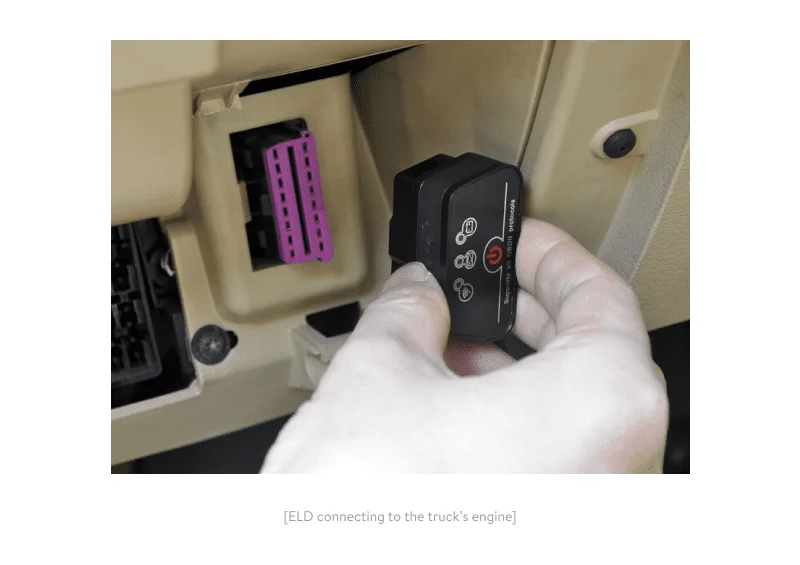
What does an e-logging mobile app do?
The minimum data that an ELD must gather includes:
- engine hours
- road speed
- miles driven
- date and time of day
Certain ELDs may include a GPS unit for location information. Otherwise, fleets may rely on a driver’s mobile device to capture the truck’s location when a duty status changes. An electronic truck logbook must also include the truck and trailer number, the name and address of the carrier, shipping document numbers, and other details.
The app on a driver’s mobile device processes data received from the engine (through a wireless connection) and creates logs that can be edited by a driver. A dispatcher also gets access to driver logs for auditing using a separate fleet app that offers additional functionality.
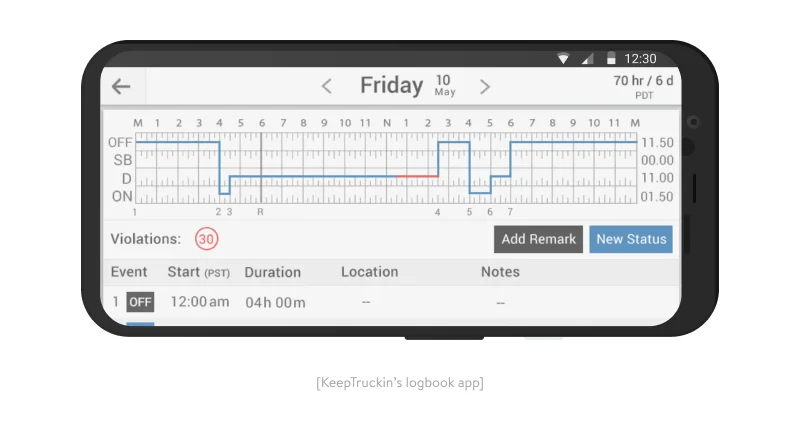
Read also: Fleet management software to increase your fleet and driver productivity
While electronic logs are at the core of both driver-focused and fleet-focused apps, other useful features may also be implemented in e-logging apps. Here are some other common features of electronic logging apps:
Form & manner alerts. A dispatcher and a driver can receive push notifications if there are logbook violations or errors.
HOS alerts. If a truck has been in continuous movement for a period of time that exceeds HOS requirements, a mobile app can send a push notification to the driver’s phone suggesting the driver take a rest. The app should send a notification at least 30 minutes before an HOS violation occurs. In case a driver doesn’t react to the alert, a push notification on an HOS violation is sent to the dispatcher, who can then alert the driver in some other manner.
Electronic DVIR. An app can create Driver Vehicle Inspection Reports (DVIRs), which are special forms needed for a compliance inspection if a vehicle has been damaged during a trip. According to a DVIR Rule issued by the FMCSA, truck drivers whose pre-trip and post-trip inspections turn up no equipment issues or safety concerns no longer need to file a report. In the event that damage to a vehicle has occurred, an app can help drivers complete the DVIR, add photos of the damage, and sign the report electronically.
Messaging. Real-time communication features with individual and group chats can enable direct connections between a fleet’s headquarters and its drivers, helping companies improve their fleet management operations.
Map.To make a trucker logbook app, you need to implement maps in your driver and dispatcher apps. For a driver, a map within the app’s interface can include live traffic information, routing, and other important road-related details such as the location of truck stops, truck washes, service and maintenance stations, fuel stations, and Wi-Fi zones. For a dispatcher, a map can show the current locations of all operating drivers.
Additionally, an app for fleets may include features for monitoring driver behavior and statistics. Incidents of unsafe and wasteful driving such as speeding, hard braking, and idle time captured by an ELD can trigger near real-time alerts to be sent to a fleet manager’s app or to their email.
An e-logging app’s interface is likely to be different for a driver than for a fleet manager. After all, fleet managers need access to broader functionality and data storage capabilities that are implemented through backend solutions.
After getting a detailed picture of the ELD situation in the US market, let’s move on to Canada and its electronic logbook solutions.
Read also: Best Mapping Solution for Logistics: Mapbox versus Google Maps
Electronic logging device (ELD) requirements in Canada
Canada introduced ELD requirements only in 2019, and the actual timing of their entry into force is still being determined. Let’s look into this in more detail.
What is the situation with the ELD regulations that take effect in 2021?
Although ELD regulations were introduced in 2019, a two-year “soft rollout” was undertaken to give everyone a chance to prepare for compliance. As promised, penalties will not be charged until June 2022. But in 2021, the requirement to use electronic logging devices (ELDs) was implemented, making the long-awaited regulation of the commercial trucking industry official. Transport Canada has estimated that ELDs will reduce fatigue-related collisions by 10 percent.
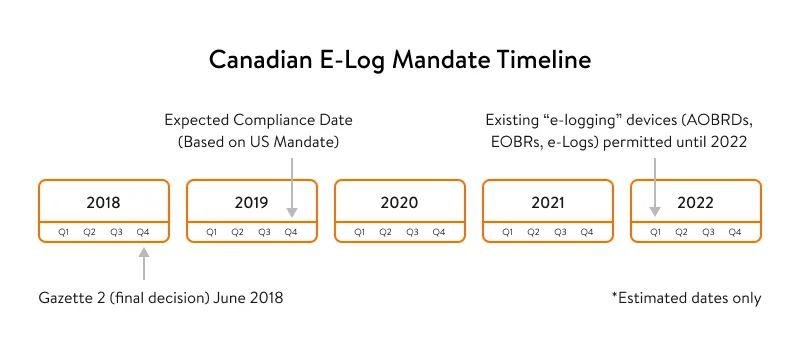
Who will be exempt from complying with the Canadian regulations?
Non-compliance will result in significant fines not only for the driver but also for the company.
Exemptions to Canadian ELD requirements are more limited than are exemptions to similar rules in the US. In Canada, drivers will have to use an ELD unless they:
- have a special permit
- are working on a rental agreement for 30 days or less
- are working on a vehicle manufactured before 2000
- are working under the short-haul exception
These factors exempt drivers from using an ELD when working within 160 kilometers (approximately 99.4 miles) of their home base.
How do the new Canadian ELD regulations compare to the US rules?
The main difference is that Canada requires third-party certification of devices to reduce instances of tampering with electronic logs. In the US, ELD manufacturers may self-certify that their devices meet regulatory requirements. Cab-Mate One is one of the certified third-party solutions on the Canadian market.
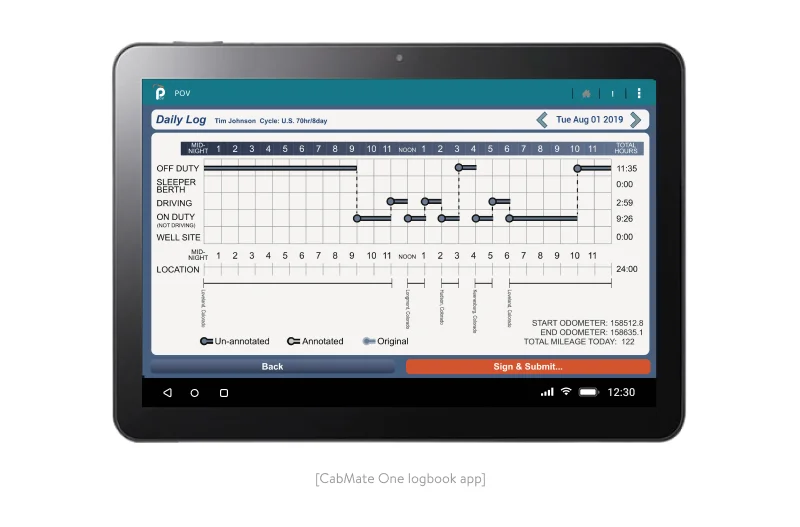
In Canada, ELDs have to go through a verification process by one of three certifying bodies: FPInnovations, CSA Group, or COMDriver Tech. These are agencies that, in turn, are accredited by the federal transportation ministry Transportation Canada. As of November 2021, only six devices had been certified for use in Canada (the regulations went into effect in June 2021).
If you operate a fleet that crosses the border, you must make sure all your ELD hardware is certified in Canada in order to legally operate in the country.
Despite Canada’s thorough preparation for and verification of ELDs, a major scandal has already taken place: a Canadian ELD tester is being investigated as a video claims devices can be cheated. The certification situation in Canada is still not fully decided. How things will go from here according to arisen critical flaws remains to be seen. What is obvious at this point are the steps every fleet should take.
Checklist of steps fleets need to take to implement ELDs:
- Determine if a new device is required either because paper logs are currently used or because the supplier is not certified in Canada
- Communicate plans to drivers and internal stakeholders
- Select a vendor
- Update policies/procedures
- Conduct driver training (refresher training on hours of service restrictions and training on how to use the selected ELD)
The United Kingdom and smart digital tachographs
In the UK, digital tachographs have been mandatory for passenger, commercial, and freight vehicles since 2006. A digital tachograph is a new generation of on-board device that digitally records professional drivers’ rest and driving hours. Since the entry into force of Annex 1C Legislation in 2019, all new commercial vehicles and trucks in the UK must be equipped with smart tachographs. The main function of the smart tachograph is to track driving activities to ensure that employers and drivers are complying with Drivers’ Hours Regulations.
These regulations apply to all new haulage and commercial transport vehicles put into service after the 15 June 2019 deadline. However, existing vehicles will have to introduce smart tachographs by 2024. It’s a big change for drivers and fleets, but also one that will reduce the transport industry’s administrative burdens and spur a reduction in data manipulation.
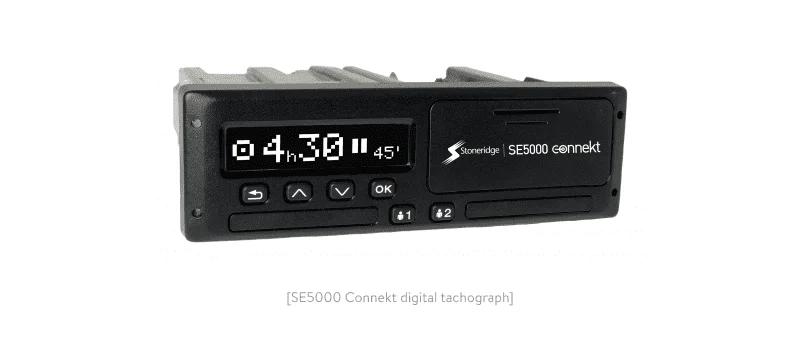
What are the differences between ELDs and smart tachographs?
Based on smart cards, motion sensors, and digital records, the new digital tachograph replaces traditional paper logbooks and mechanical tachographs that have been used to monitor commercial vehicle drivers to date.
First of all, the digital tachograph goes a little further than an ELD and records whether a driver is driving or taking a break. It automatically records the vehicle’s location using GPS at the starting point for the work period, then records the location after every two hours of accumulated driving time (or at any other predefined interval) and finally at the end point for the work period.
In addition to recording the distance covered by the driver and the movement of the vehicle, UK digital tachographs are equipped with a GNSS (Global Navigation Satellite System) module, which:
- automatically records the location of the vehicle at the start and end of a journey
- updates the location every two hours when the vehicle is on the move
Moreover, a digital tachograph records the vehicle’s speed for every second of travel, not the vehicle’s engine operation data, as ELDs do.
It’s worth mentioning that the DSRC (Dedicated Short Range Communication) interface can be used by law enforcement officers to check certain tachograph data without having to stop the vehicle. This means drivers will not have to waste time on the road and law enforcement officers can easily identify potential offenses. However, as stated in the EU regulation cited by Legislation.gov.uk, no confidential or private driver or vehicle data will be shared.
How do digital tachographs work for commercial vehicles?
Digital tachographs store data on drivers and their driving, rest, and work periods for up to 12 months. Unlike analog devices, digital tachographs also store information about vehicle malfunctions, tampering attempts, speeding, calibration information, and when data was accessed, for example by the police.
The new digital tachographs offer many benefits, including the ability to seamlessly comply with transport legislation in all EU Member States, which is particularly useful for vehicles and fleets crossing EU borders.
Each driver receives a personal smart card that they insert into the digital tachograph device while driving, allowing details of their journeys to be recorded. This information is then downloaded and stored digitally by fleet owners to help them meet legal obligations.
To summarize, the main things your tachograph must comply with are the Drivers Hours’ Legislation and the Working Time Directive. The tachograph should provide a GNSS receiver and full Dedicated Short Range Communications (DSRC) support.
Australia and electronic work diaries (EWD)
Australia is not in such a hurry to integrate electronic logging solutions as the other countries we’ve discussed. Since the National Heavy Vehicle Regulator approved Electronic Work Diaries in 2018, EWDs can be used by heavy vehicle drivers as an alternative to records in a written work diary.
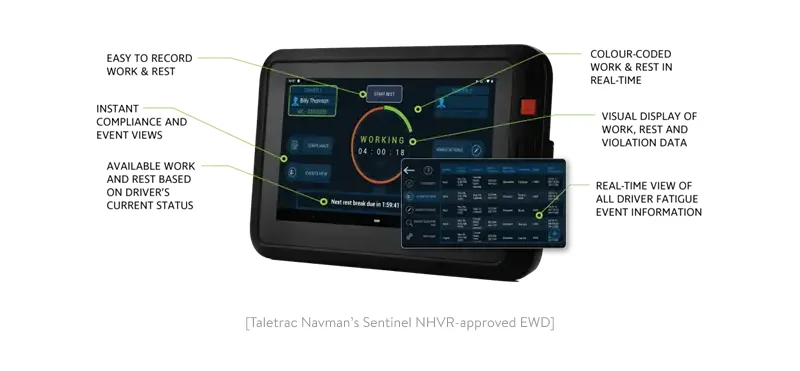
The main concern for implementing an EWD as a proactive solution is managing the fatigue of transport operators.
How do EWDs differ from written work diaries?
At the moment, EWDs and written drivers’ diaries have one function in common: they both ensure a driver’s work and rest hours comply with HVNL laws and monitor driver fatigue.
The difference begins with the fact that an EWD is a digital system that can accurately and automatically calculate driving time, speed, and fatigue levels. No more manual calculations or time-consuming paperwork. An EWD also reduces the risk of incorrect data, data damage, or lost records. Another tangible difference is that an EWD tracks trips to the exact minute, while paper diaries track time in 15-minute intervals.
An EWD gives real-time alerts not only to the driver but also to managers so they don’t miss a moment of needed rest. In terms of administration, EWDs reduce unnecessary paperwork and administrative costs. This helps drivers, managers, and companies stay organized and compliant. It also helps drivers and managers free up time so they can focus on more important tasks.
EWD solutions for Australia
EWDs calculate time and remind drivers about rest breaks automatically. They also send alerts about potential fatigue violations to the operations department in real time so department staff can take corrective actions.
The main advantages of electronic HOS EWD logging software are:
- An easy-to-use interface for logging work and rest hours
- Audible and visual alerts to prevent fatigue
- Protection against unauthorized access to work and rest events
- Driver documentation management
- Real-time availability review for dispatchers
A custom EWD solution eliminates almost all NHVAS fatigue-related paperwork and provides real-time fatigue-checking fleet operations. Currently, there are five electronic logbook providers in Australia that can develop EWDs.
If you’re looking for a provider who can start developing custom logbook software or if you want to maintain full control over your ELD and GPS data, you can rely on Yalantis. With expertise creating logistics tracking software, we’ll create the most efficient solution that meets your needs.
Does your logistics business need a powerful custom software solution?
We can assist you in building it
Check out our expertiseRate this article
4.2/5.0
based on 125 reviews





